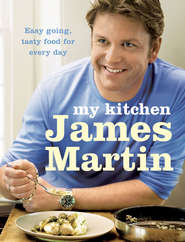По всем вопросам обращайтесь на: info@litportal.ru
(©) 2003-2024.
✖
Masterclass Text Only: Make Your Home Cooking Easier
Настройки чтения
Размер шрифта
Высота строк
Поля
4 tsp chopped flat-leaf parsley
2 tsp chopped chives
1. Drizzle 1 tablespoon of the olive oil into a non-stick roasting tin and place the sardines on it, skin side up, then season with salt and pepper.
2. In a bowl, mix together the garlic, shallots and thyme with the remaining oil, then spoon over the top of the sardines and leave to marinate for 15 minutes.
3. Preheat the grill to medium or the oven to 170°C (325°F), Gas 3.
4. Place the sardines under the grill or in the oven and cook for 4–5 minutes, without turning.
5. While the sardines are cooking, make the dressing. Pour the vinegar into a bowl and add the sugar, allowing it to dissolve. Add the olives, rapeseed oil and herbs, mix together and set aside.
6. Arrange the salad leaves on individual plates, then remove the sardines from the grill or oven and place 3 on top of each portion of salad. Drizzle over the dressing and serve with crusty bread.
SALT-CRUSTED SEA BASS (#ulink_72186018-2029-58b9-bf1a-f313853c15be)
You may look daft buying this much salt; people may think you’re stocking up for an icy garden path. Little do they know it’s actually for this dish, one of the best ways to bring out all the flavour of sea bass. If you can’t find good bass (they are farmed now, so generally not too pricey) you can use trout. It must be sea salt, not fine table salt – use that for the path and keep the good stuff for your food. Cracking the crust at the table is quite an event. The fish doesn’t end up tasting salty, it’s just pure, white, delicious flesh.
SERVES 2
1.2kg (2lb 10oz) sea salt
3 egg whites
1 small bunch of dill, stalks removed and reserved, leaves chopped
1 x 750g (1lb 10oz) whole sea bass, gutted, scales removed and head and tail cut off
Handful of edible seaweed
1. Preheat the oven to 200°C (400°F), Gas 6.
2. Place the sea salt in a large bowl and add the egg whites and chopped dill. Stuff the cavity of the fish with the reserved dill stalks.
3. Cover the bottom of a deep roasting tin with about one-third of the sea salt mixture and then scatter over the seaweed. Put the sea bass on top and cover with the remaining salt mixture, making sure the whole of the fish is covered, underneath as well as on top. Pat the fish down and then place in the oven to bake for 25 minutes or until the salt crust sounds hard when tapped with the back of a teaspoon.
4. Remove the tin from the oven and crack the salt crust to reveal the cooked fish – the skin should peel away easily. Serve with a salad of crisp lettuce leaves, such as Little Gem, tossed in olive oil and lemon juice.
‘James has a knack for making food and recipes that are positively inspirational.’
KEN HOM
PROPER FISH AND CHIPS (#ulink_3d2c0f00-d23e-5d27-b7c0-ed87d431709c)
If I were ever on Mastermind then I would choose this dish as my specialist subject! Over the years, I’ve sampled good and bad. I’ve travelled miles to get my hands on that crisp batter and pure white flesh, and once drove my team on a 500-mile round trip to prove that the best fish and chips were from my home county of Yorkshire. So this batter recipe is one that has been brought to you after eating many hundreds of fish and pounding thousands of miles, look after it and enjoy!
SERVES 4
1.2 litres (2 pints) vegetable oil, for deep-frying
4 large peeled potatoes (about 1.5kg/3lb 4oz)
4 x 175g (6oz) fillets of cod, haddock or pollack, pin bones removed
Salt
FOR THE BATTER
225g (8oz) self-raising flour
1 tsp salt
15g (½oz) fresh yeast or 20g (¾oz) dried yeast
2 tsp cider or white wine vinegar
1 tsp caster sugar
200ml (7fl oz) beer
1. To make the batter, sift the flour and salt into a bowl and add the yeast, vinegar and sugar, then whisk in the beer and, once combined, set aside for 45 minutes to 1 hour to bubble up.
2. If using a deep-fat fryer, heat the vegetable oil to 95°C (200°F). Alternatively, fill a deep, heavy-based saucepan to one-third with oil and use a sugar thermometer to check that it has reached the correct temperature. (Take great care if using a saucepan: always watch over it and never fill it beyond more than a third as the hot fat may bubble up when the food is added.)
3. Trim the potatoes into rectangles, cut into slices 1cm (½in) thick, then cut again to give chips that are 1cm (½in) wide. Place the chips in the deep-fat fryer or saucepan and cook for 10 minutes. (It is very important to pre-cook them in this way to ensure that they are cooked through before serving. Frying the chips at this temperature will blanch them without browning.)
4. Check the chips are tender using the point of a knife, then remove from the oil and drain on kitchen paper. They can be left to cool on greaseproof paper and even chilled before finishing.
5. Preheat the oil in the fryer or pan to 190°C (375°F). Immerse the fish fillets in the batter, then carefully lower into the hot oil and cook for 3–4 minutes or until golden brown. Remove from the oil and drain on kitchen paper, then reheat the oil to cook the chips.
6. Lower the chips into the oil. These will now take only 2–3 minutes to become golden brown and crispy. Shake off any excess fat, or drain on kitchen paper, and sprinkle with salt before serving with the fish.
SKATE WINGS WITH BLACK CAPER BUTTER (#ulink_eb19d284-8f1b-56c5-a0ba-f6867c82740f)
This is one of the classic butter sauces; the trick is the get the pan nice and hot before adding the butter. Once the butter is brown, pull the pan off the heat, add the rest of the ingredients and serve straight away. This sauce can be served with all manner of fish and seafood, from salmon and trout to hake and prawns. I’ve chosen to put it with skate wings, which are attractive and a bit different to serve up to your guests.
SERVES 2
2 x 225g (8oz) skate wings, skinned
FOR THE COOKING LIQUOR
1 onion, peeled and chopped into 2cm (¾ in) pieces
2 sticks of celery, trimmed and chopped into 2cm (¾ in) pieces
250ml (9fl oz) white wine








